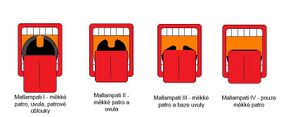Classification of intubation approach according to mallampati
Mallampati's classification describes the relationship between the size of the language and the pharyngeal area, it is used to estimate the difficulty of intubation. During the examination, the patient opens his mouth as much as possible and sticks out his tongue. Ideally, we perform the examination with the patient sitting, but it is also possible to perform it lying down..
| Mallampati | |
|---|---|
| I | We see the soft palate, the entire uvula, the pharynx, the entire tonsils. |
| II | We can see the soft palate and most of the uvula. |
| III | Only the soft palate and root of the uvula are visible. |
| IV | Almost nothing is visible, not even the soft palate. |
With classification I, we expect trouble-free laryngoscopic clarification of the entire entrance to the larynx. For grades II and III, we can expect almost any finding during laryngoscopy, for these patients the classification is unreliable. In the case of patients with stage IV according to Mallampati, we must always be prepared for the possibility of difficult intubation , as the vocal cords are often not visualized.
Links[edit | edit source]
Related articles[edit | edit source]
References[edit | edit source]
LARSEN, Reinhard. Anesthesia. 7. edition. Grada Publishing, 2004. 1376 pp. ISBN 9788024704760.

